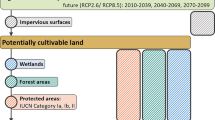Abstract
Five assessments covering less-developed countries have identified a ‘land balance’, available for future cultivation, using the approach of inventory and difference: assessment of the area cultivable, and subtraction of the area presently cultivated. All arrive at a balance of 1600–1900 Mha, about twice the present cultivated area. The supposed existence of this spare land is widely quoted in forecasts of capacity to meet the food requirements for future population increase. It is argued here that these estimates greatly exaggerate the land available, by over-estimating cultivable land, under-estimating present cultivation, and failing to take sufficient account of other essential uses for land. Personal observation suggests that the true remaining balance of cultivable land is very much smaller, in some regions virtually zero. An order-of-magnitude estimate reaches the conclusion that in a representative area with an estimated ‘land balance’ of 50%, the realistic area is some 3–25% of the cultivable land. This speculation could be tested by directly attempting to find such land in areas where it is supposed to exist. The impression given by current estimates, that a reserve of spare land exists, is misleading to world leaders and policy-makers.
Similar content being viewed by others
References
Allan, W.: 1965, The African Husbandman, London, Oliver and Boyd.
Alexandratos, N.: 1995, World Agriculture: Towards 2010. An FAO Study, Chichester, UK, Wiley, for FAO.
Döös, B.R.: 1994, ‘Environmental degradation, global food production, and risk for larger-scale migrations’, Ambio 23: 124-130.
Evans, L.T.: 1998, Feeding the Ten Billion: Plants and Population Growth, Cambridge, UK, Cambridge University Press.
FAO: 1970–80, Soil Map of the World 1: 5000. Vols. 1–10, Paris, UNESCO.
FAO: 1978–81, Report on the Agro-ecological Zones Project, FAO World Soil Resources Report 48/1-4, Rome, FAO.
FAO: 1981, Agriculture: toward 2000, Rome, FAO.
FAO: 1983, Potential Population Supporting Capacities of Lands in the Developing World, Rome, FAO.
FAO: 1984, Land, Food and People, Rome, FAO.
FAO: 1996a, Rome Declaration on World Food Security and World Food Summit Plan of Action, Rome, FAO.
FAO: 1996b, World Food Summit: Technical Background Documents 1-15, Rome, FAO.
FAO: annual, FAO Production Yearbook, Rome, FAO.
FAO: ongoing, FAOSTAT (statistical database), World Wide Web site, http:/apps.fao.org.
Fischer, G. and Heilig, G.K.: 1998, ‘Population momentum and the demand on land and water resources’, in D.J. Greenland, P.J. Gregory and P.H. Nye (eds.), Land Resources: on the Edge of the Malthusian Precipice?, Wallingford, UK, CAB International, pp. 9-29.
Greenland, D.J., Gregory, P.J. and Nye, P.H.: 1998a, ‘Introduction and conclusions’, in D.J. Greenland, P.J. Gregory and P.H. Nye (eds.), Land Resources: on the Edge of the Malthusian Precipice?, Wallingford, UK, CAB International, pp. 1-7.
Greenland, D.J., Gregory, P.J. and Nye, P.H.: 1998b, ‘Land resources and constraints to crop production’, in J.C. Waterlow, D.G. Armstrong, L. Fowden and R. Riley (eds.), Feeding a World Population of more than Eight Billion People, Oxford, UK, Oxford University Press, pp. 39-55.
Luyten, J.C.: 1995, Sustainable World Food Production and Environment, Wageningen, The Netherlands, AB-DLO.
Myers, N.: 1980, Conversion of Tropical Moist Forests, Washington DC, National Academy of Sciences.
Oldeman, L.R., Hakkeling, R.T.A. and Sombroek, W.G.: 1990, World Map of the Status of Human-induced Soil Degradation, Wageningen, International Soil Reference and Information Centre (ISRIC) and UNEP.
Pagiola, S.: 1995, Environmental and Natural Resource Degradation in Intensive Agriculture in Bangladesh, World Bank Environment Working Paper 15. Washington DC, World Bank.
Sehgal, J. and Abrol, I.P.: 1992, ‘Land degradation status: India’, Desertification Bulletin (UNEP) 21, 24-31.
Stoorvogel, J.J. and Smaling, E.M.A.: 1990, Assessment of Soil Nutrient Depletion in Sub-saharan Africa: 1983–2000, Staring Centre Report 28. Wageningen, The Netherlands: Staring Centre.
WHO: 1996, Micronutrient Malnutrition — Half the World's Population Affected, World Health Organization 78, 13 November 1996, pp. 1-4.
World Resources Institute, UNEP, UNDP, and World Bank: 1996, World Resources 1996/97, Oxford, UK and New York, Oxford University Press.
Young, A.: 1991, ‘Soil monitoring: a basic task for soil survey organizations’, Soil Use and Management 7: 126-130.
Young, A.: 1994, Land Degradation in South Asia: its Severity, Causes and Effects upon the People. FAO World Soil Resources Report 78. Rome, FAO.
Young, A.: 1998, Land Resources: Now and for the Future, Cambridge, UK, Cambridge University Press.
Young, A: in press, ‘Malawi 1959–1999: a 40-year perspective’, Tropical Agriculture Association Newsletter 19(2).
Young, A.: ongoing, Land-resources.com, World Wide Web site, http://www.land-resources.com.
Author information
Authors and Affiliations
Rights and permissions
About this article
Cite this article
Young, A. Is there Really Spare Land? A Critique of Estimates of Available Cultivable Land in Developing Countries. Environment, Development and Sustainability 1, 3–18 (1999). https://doi.org/10.1023/A:1010055012699
Issue Date:
DOI: https://doi.org/10.1023/A:1010055012699




